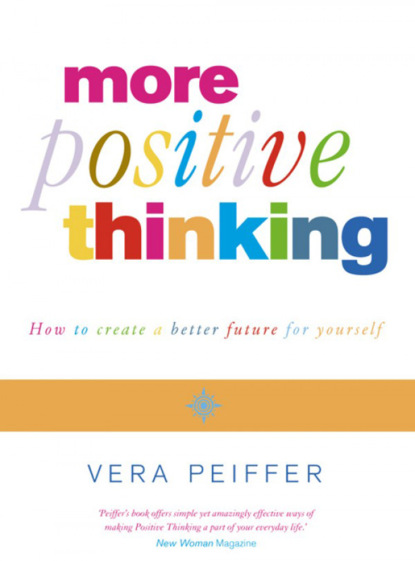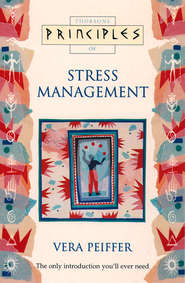По всем вопросам обращайтесь на: info@litportal.ru
(©) 2003-2025.
✖
Positive Thinking: Everything you have always known about positive thinking but were afraid to put into practice
Автор
Год написания книги
2018
Настройки чтения
Размер шрифта
Высота строк
Поля
Note: The best time to act on new resolutions is now (not the 1st January).
I know you can do it!
VERA PEIFFER
PartOne (#ulink_4b165665-65a5-5766-b9d1-e4e37707307d)
1 Mind over matter: The Pendulum Experiment (#ulink_66bbac31-f549-574b-9604-2d6bb3365f81)
Before we get into theoretical discussions of how the mind works, I would like you to try the following experiment.
Find a piece of string and tie a ring to one end of it. It is quite unimportant what sort of string you use or what kind of object you tie to the end – if you don’t have a ring, use a key or a pen with a clip. The main thing is that you can fasten it somehow to the end of your string.
Now tie the other end of the string around your right index finger. As it is important to keep your right hand perfectly still, I suggest you sit down at a table, firmly rest both elbows on the table and support your right wrist with your left hand.
Lower your right index finger to allow the object to rest on the table, then gently lift the index finger again so that the object hangs still. It is of the utmost importance that you do not move your hand while you carry out this experiment.
Now fix your gaze on the object and begin to imagine that the pendulum starts swinging from left to right. See the movement in your mind, imagine how the object begins to swing, left to right, left to right. Say it silently to yourself, ‘Left to right to left to right’, and you will see that the pendulum actually begins to swing from left to right. It will begin to swing very slightly first, so keep on imagining, seeing in your mind’s eye how the movement is becoming more pronounced, and you will see that this, too, will happen.
Now lower your hand once more, resting the object on the surface of the table. Again, lift the object away from the surface gently so that it hangs free, and now imagine that it begins to swing around in a clockwise circle. Move your eyes in a clockwise circle around the object, see the movement, and very slowly you will notice that the pendulum begins to swing accordingly. All the while make sure you do not move the hand that is holding the pendulum.
Of course you can also make the pendulum swing in an anti-clockwise circle or away from you and towards you. The result is always the same: the pendulum follows the imagined direction. Fascinating, isn’t it?
However, before you give up your job to become a world-famous stage artist in the pendulum-swinging field, let us just have a look at what has been happening here. You were determined to hold your hand perfectly still, and, at the same time, imagined that the pendulum would begin to move in a particular direction. In other words, your will-power was in conflict with your imagination.
Note: When your will-power conflicts with your imagination, your imagination will always win out.
Just consider another example. I am sure you know someone who has attempted their driving test and failed, although they were perfectly capable of doing their three-point turn and manoeuvring the car into a parking space under non-test conditions. The ‘nerves’ these people display in the test situation are nothing but the conflict between will-power and imagination. They want to pass the test, they want to perform well … but they imagine that they will fail and, as we have seen with the pendulum experiment, the imagination is more powerful than the will, and, consequently, the candidate tenses up, panics, and fails his or her driving test. In order to support your wishes effectively, you have to make sure that your imagination runs along the same lines as your wish, but more of this later.
So, what are you going to do if your pendulum didn’t swing and you are now red in the face and contemplating using the pages of this book to wrap your sandwiches in?
Note: Never give up.
The difference between a successful person and an unsuccessful person is that the successful person goes on where the unsuccessful person gives up. So, try again!
You may not be in the habit of using your imagination very often, but it is certainly a skill that can be acquired by practising. Children tend to have very good imaginations, so if you have lost the ability as an adult, you will simply have to re-learn it by using it more often. Using your imagination is a bit like riding a bicycle: you don’t ever completely forget it. (You will find an exercise for improving your imagination on page 24.)
2 The Subconscious Mind (#ulink_8aaaaf91-4966-5e70-ac3e-e4f83afff7f3)
The mind, just like an iceberg, consists of two parts: like the tip of the iceberg, there is the conscious mind, which helps us with daily decision-making processes and also assists us with new situations where we have to apply rational thinking to fathom out what to do and how to do it. On the other hand, there is the subconscious mind, which makes up the far greater part, just like the submerged part of the iceberg. The subconscious mind deals with the repetitions of learned behaviour. This can be very helpful because it enables us to deal with situations more quickly when they occur again. Once we have learned to deal with a situation we find it easier next time around because we are using information that is already stored. For example, once we have learned that the oven door is hot we will use a cloth to open it the next time we have to do it, rather than burn our fingers again; once we know how to change gear in the car, we don’t have to consciously think about it any more because the stored information comes up automatically as soon as the situation arises again; once we have learned where the letters are on a computer keyboard, we can type without looking because we have formed a mental picture in our subconscious mind of what the keyboard looks like.
Information from the conscious mind feeds directly into the subconscious mind. There is a strong link between the two parts of the mind. Everything you have ever seen, heard or experienced is perceived by the conscious mind and then stored away into the subconscious mind as a memory. This memory is stored as the incident itself plus the feeling that went with it at the time.
Let us assume you are bitten by a dog. You live through the actual incident and experience all the feelings of shock, hurt and anxiety that accompany the event. That incident and those feelings now get stored away in the subconscious. This memory influences your behaviour in similar situations. Next time you see a dog you will act according to your memory pattern, that is, you will experience anxiety when you walk past a dog or, if the shock at the time was particularly strong, you may even cross over to the other side of the street to avoid the dog.
Let me give you another example. Let us assume that someone tells you repeatedly that you are useless. This other person can be your father, mother, husband, wife, girlfriend, boyfriend, boss or anybody who is in a position of authority or very close to you. The accusation can be unfounded or exaggerated, but if it is repeated over and over again, it will still get stored away in your subconscious mind, and, once again, the feeling of anger, resignation or depression you feel will go with it.
When the other person is given the opportunity to repeat their accusation over and over again over a long period of time, you will begin to feel that you really are useless and incapable of doing anything right because that is the automatic message you get from your subconscious whenever a new situation arises where you have to prove yourself.
You are now entering a vicious circle: because you believe you are useless, you will act out that belief; because you do not tackle any new situations you feel like a failure, and therefore you fail, and now the initial accusation has become true, like a self-fulfilling prophecy, even though you may never have been useless in the first place.
These two examples demonstrate that there is a link between the information or events we experience consciously (facts), the consequent subconscious storing of the event together with the accompanying feelings (memory) and the subsequent way we act (behaviour) when we find ourselves in the same situation again.
When we find that, for some reason, we cannot cope with a situation, this will leave our subconscious mind with a piece of negative information, with a memory trace of failure, and when the same or similar situation presents itself again, we will automatically assume that we are unable to cope. This assumption means that we are expecting things to go wrong again, we imagine ourselves incapable of handling the situation and, therefore, we will ultimately be unable to escape what we have imagined.
Note: Once the fact-memory-behaviour chain has been established, it works automatically.
There is, of course, also the possibility that you can no longer recall the incident itself, but you will nevertheless still experience the feeling that went with it as soon as you encounter a similar situation. You may well have forgotten that you were bitten by a dog at the age of two, but your subconscious mind will ‘remind’ you of the incident by emitting that feeling of fear that went with it at the time.
Feelings do not overcome us out of the blue, they are always linked to a real incident, which we may very well have forgotten, for whatever reason. The stronger the negative feeling that accompanied the event, the more likely it is that the incident has been repressed, that is, the more likely it is that we no longer remember it.
Note: Feelings that have been stored away in the memory will always be discharged as behaviour.
The good news is that the fact-memory-behaviour chain also works in a positive way. If you have been told that you are loved, even when you make mistakes, then your subconscious mind will register this information as a feeling of security, together with the message that you are loved no matter what, and you will then go and try out new things without being too frightened about the outcome because you know that, even if it does not work out, your sense of security and self-esteem will still be intact.
You will have noticed that I emphasise that information has to be given repeatedly before it takes root in the subconscious mind and that an incident has to be accompanied by a particularly strong emotion to impress itself on the subconscious and thus influence consequent behaviour.
These are points that are important to bear in mind:
Note: The more often a message is repeated, the deeper it is impressed on the subconscious.
Note: The stronger the emotion accompanying an event, the stronger that emotion is impressed on the subconscious.
3 What is Positive Thinking? (#ulink_07fe1eda-28eb-54c7-b30a-330534187836)
Positive Thinking is making use of the suggestibility of your subconscious mind in a positive way. We have seen in the previous chapters that information passes from the conscious mind to the subconscious.
The subconscious mind does not reason, it does not judge whether the information is right or wrong, sensible or silly, true or false, it just stores it like a faithful servant, only to produce behaviour at a later stage that accords with the stored information.
If we want to influence our behaviour or our performance, we have to do so via our subconscious mind, and that means we have to select new, positive thoughts that we consciously and repeatedly feed into our conscious mind because repeated thoughts take root in the subconscious mind. Repeated negative thoughts will influence it negatively and negative results will materialise as thoughts, wishes and ideas are translated into reality by the subconscious mind. We have to turn these round so that positive behaviour results.
Note: The quality of your thoughts determines the quality of your life.
You really and truly are what you think. Consider the following situation. It is 7.30 a.m. You have just woken up. As you begin to open your eyes, your conscious mind slowly moves into gear and you begin to think about the day that lies in front of you. You think about a meeting you will have to attend in the morning where you have to concede that you were unable to solve a particularly urgent problem, and, on top of this, you will have to confront a troublesome customer in the afternoon. It is still 7.30 in the morning. Nothing has actually happened yet, but you are already in a bad mood.
I can hear loud cries of protest now of, ‘I would like to see you in my place, having to face that crowd of uncooperative half-wits!’, or, ‘If you’re so clever why don’t you come and try to deal with my customer! He does nothing but shout all the time!’, and so on. But, just a minute. I’m not denying that the meeting is difficult and your customer an awkward person, but what I am saying is that you will not do yourself any favours by being in a bad mood on top of all that, because that only makes things more difficult.
If you are in a bad mood, you are simply not at your best. You are tense, irritable and, therefore, out of control. You cannot concentrate, you are frightened and you feel panicky. And, of course, the story does not end there. Because you are in a bad mood, you may be particularly monosyllabic or grumpy at breakfast, which is not going to endear you to the family. You will be a touch unfriendly with your colleagues at work who, in turn, will possibly comment on your mood and that will really get your back up (‘Why don’t they mind their own business?’) – and then the meeting is postponed until next week. This is possibly the worst thing that could happen, because it means that you will have another week’s worrying to do until it is finally over. Or, if the meeting does take place that day, you have already spent all your valuable energy on getting worked up. In the evening you will go home, exhausted, kick the dog and wonder whether you are really being paid enough for this demanding job …
By this time, something should dawn on you. Yes, I’m going to say it: you are responsible for wasting your energy in this manner – it is not the job, it is you! It was your negative thinking first thing in the morning that got you started on the wrong track.
There is nothing you can do about certain events in your life – meetings will occur, customers will sometimes be difficult – but you can certainly do something about the way you choose to look at these events. By putting yourself into a positive frame of mind, you will not only feel better within yourself, but you will also cope better with the event, and, above all, you will influence your environment positively. People like being with a relaxed, happy person and your positive attitude will soon be reflected in the way other people treat you.
Note: Whatever you send out to others will come back to you like a boomerang.
The above note is true – always. It is just a matter of time before you reap what you have sowed. This is true for all areas, be it in private life or business.
Being positive means being open and friendly. It does not mean being anybody’s doormat. It means saying what you want and going for it. It does not mean being a bully. Being positive means consciously choosing to look on the bright side. It does not mean seeing the world through unrealistic rose-tinted spectacles. Being positive means liking yourself and others, it means taking an interest in the people around you.







